一般过去时知识点资料讲解
- 格式:doc
- 大小:21.50 KB
- 文档页数:6

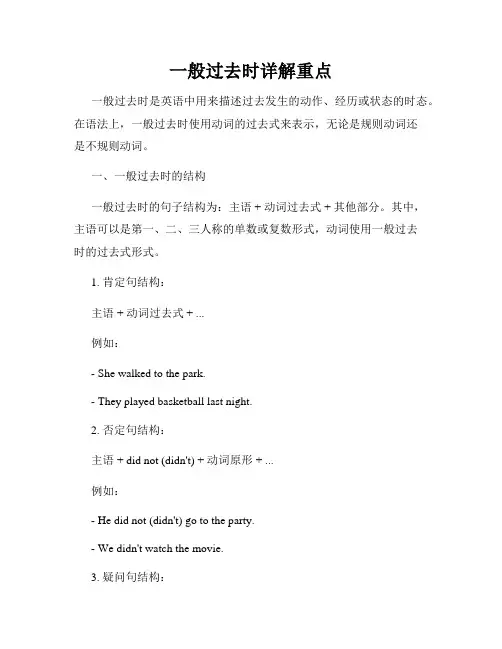
一般过去时详解重点一般过去时是英语中用来描述过去发生的动作、经历或状态的时态。
在语法上,一般过去时使用动词的过去式来表示,无论是规则动词还是不规则动词。
一、一般过去时的结构一般过去时的句子结构为:主语 + 动词过去式 + 其他部分。
其中,主语可以是第一、二、三人称的单数或复数形式,动词使用一般过去时的过去式形式。
1. 肯定句结构:主语 + 动词过去式 + ...例如:- She walked to the park.- They played basketball last night.2. 否定句结构:主语 + did not (didn't) + 动词原形 + ...例如:- He did not (didn't) go to the party.- We didn't watch the movie.3. 疑问句结构:Did + 主语 + 动词原形 + ...?例如:- Did you see the accident?- Did they go to the beach?二、一般过去时的用法1. 表示过去发生的具体动作或事件:例如:- I watched a movie yesterday.- They visited their grandparents last summer.2. 表示过去的习惯或常态:例如:- She always played tennis when she was young.- We usually went camping during the summer.3. 与过去的时间状语连用:时间状语可以是具体的时间点、时间段或表示频率的词语。
例如:- She finished her homework yesterday.- We lived in that house for five years.- He often went swimming on weekends.4. 与表示过去的连词连用:表示过去的连词如“when”、“while”、“as soon as”等可以与一般过去时连用,表示过去某一时间点或一段时间内发生的动作。
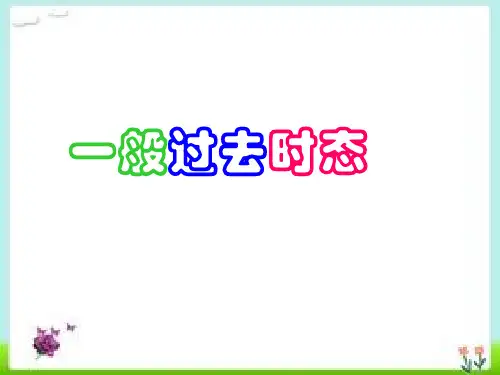
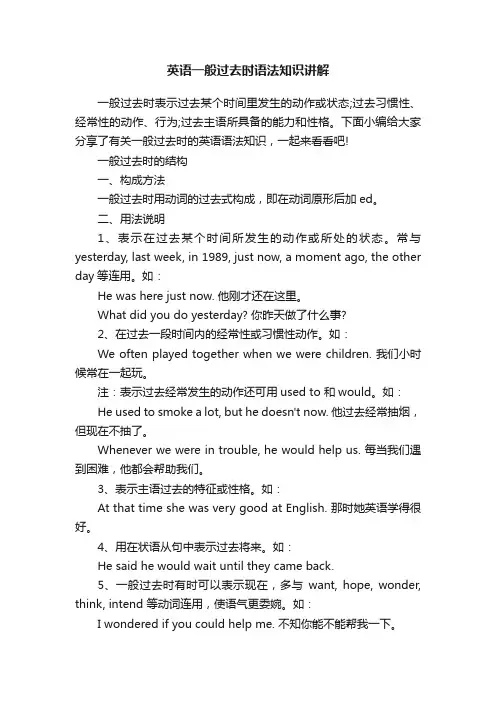
英语一般过去时语法知识讲解一般过去时表示过去某个时间里发生的动作或状态;过去习惯性、经常性的动作、行为;过去主语所具备的能力和性格。
下面小编给大家分享了有关一般过去时的英语语法知识,一起来看看吧!一般过去时的结构一、构成方法一般过去时用动词的过去式构成,即在动词原形后加ed。
二、用法说明1、表示在过去某个时间所发生的动作或所处的状态。
常与yesterday, last week, in 1989, just now, a moment ago, the other day等连用。
如:He was here just now. 他刚才还在这里。
What did you do yesterday? 你昨天做了什么事?2、在过去一段时间内的经常性或习惯性动作。
如:We often played together when we were children. 我们小时候常在一起玩。
注:表示过去经常发生的动作还可用used to 和would。
如:He used to smoke a lot, but he doesn't now. 他过去经常抽烟,但现在不抽了。
Whenever we were in trouble, he would help us. 每当我们遇到困难,他都会帮助我们。
3、表示主语过去的特征或性格。
如:At that time she was very good at English. 那时她英语学得很好。
4、用在状语从句中表示过去将来。
如:He said he would wait until they came back.5、一般过去时有时可以表示现在,多与want, hope, wonder, think, intend 等动词连用,使语气更委婉。
如:I wondered if you could help me. 不知你能不能帮我一下。
6、有时用一般过去时也是时态一致的需要。
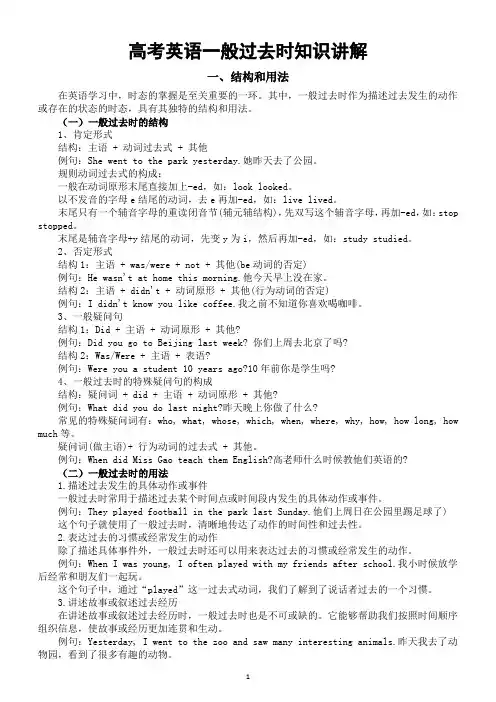
高考英语一般过去时知识讲解一、结构和用法在英语学习中,时态的掌握是至关重要的一环。
其中,一般过去时作为描述过去发生的动作或存在的状态的时态,具有其独特的结构和用法。
(一)一般过去时的结构1、肯定形式结构:主语 + 动词过去式 + 其他例句:She went to the park yesterday.她昨天去了公园。
规则动词过去式的构成:一般在动词原形末尾直接加上-ed,如:look looked。
以不发音的字母e结尾的动词,去e再加-ed,如:live lived。
末尾只有一个辅音字母的重读闭音节(辅元辅结构),先双写这个辅音字母,再加-ed,如:stop stopped。
末尾是辅音字母+y结尾的动词,先变y为i,然后再加-ed,如:study studied。
2、否定形式结构1:主语 + was/were + not + 其他(be动词的否定)例句:He wasn't at home this morning.他今天早上没在家。
结构2:主语 + didn't + 动词原形 + 其他(行为动词的否定)例句:I didn't know you like coffee.我之前不知道你喜欢喝咖啡。
3、一般疑问句结构1:Did + 主语 + 动词原形 + 其他?例句:Did you go to Beijing last week? 你们上周去北京了吗?结构2:Was/Were + 主语 + 表语?例句:Were you a student 10 years ago?10年前你是学生吗?4、一般过去时的特殊疑问句的构成结构:疑问词 + did + 主语 + 动词原形 + 其他?例句:What did you do last night?昨天晚上你做了什么?常见的特殊疑问词有:who, what, whose, which, when, where, why, how, how long, how much等。
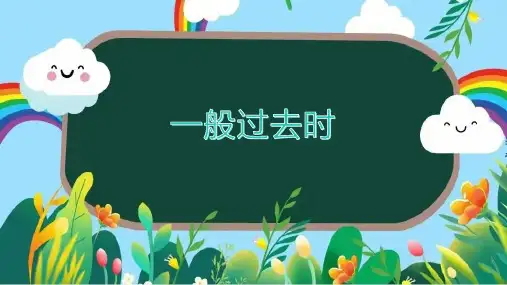

一、一般过去时的概念:一般过去时用来表示过去某一时间内发生的动作或存在的状态以及过去习惯性、反复性的动作。
谓语动词要用动词的过去式,常和表示过去的时间状语连用,如yesterday昨天、last night昨晚、last week上周、last year去年,等。
二、一般过去时的结构:(可分三类不同的结构)1.Be动词的一般过去时在没有实义动词的句子中使用be动词, am is 的过去式为was; are的过去式为were肯定句式:主语 + be(was , were) + 其它.否定句式:主语 + be(was , were) + not + 其它.一般疑问句:Be(was , were) + 主语 + 其它?注:在这种构成中,be动词有人称和数的变化,即要根据主语选用was / were。
Be动词分为单数和复数,was是表示单数,were是表示复数。
2. 实义动词的一般过去时态肯定句要使用动词的过去式,否定句和疑问句要使用助动词do和 does 的过去式 did.肯定句式:主语 + 动词(过去式)+ 其它否定句式:主语 + didn’t + 动词(原形)+ 其它【did not = didn’t】一般疑问句:Did + 主语+ 动词(原形)+ 其它【do , does的过去时均为did】?注:did和didn’t是构成一般过去时的助动词,其特点是要在其后跟动词的原形。
3. 情态动词的一般过去时态含有情态动词的一般过去时与含有Be动词的一般过去时,是十分相似,请注意观察。
肯定句式:主语 + 情态动词 + 其它.否定句式:主语 + 情态动词 + not + 其它.一般疑问句:情态动词 + 主语 + 其它?注:情态动词的过去式:can→could , may→might , must→must,will-would,should-should.4.特殊疑问句式:特殊疑问词+be过去式+主语+其他?特殊疑问词+情态助动词过去式+主语+动词原形+其他?特殊疑问词+do/does过去式+主语+动词原形+其他?What was your former name?你以前叫什么名字?Why did he late for school last Monday?上星期一他为什么迟到?What could she do twenty years ago?20年前她能做什么?三、一般过去时的判断标志词yesterday , the day before yesterday , last + 时间 , this morning时间 + ago , just now , a moment ago , in + 过去的时间 .四、规则动词的过去式1.一般情况下,在动词原形后面加-ed。
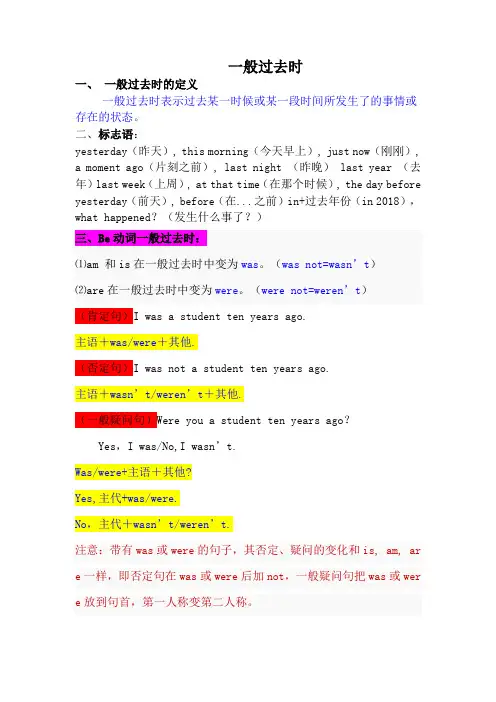
一般过去时一、一般过去时的定义一般过去时表示过去某一时候或某一段时间所发生了的事情或存在的状态。
二、标志语:yesterday(昨天), this morning(今天早上), just now(刚刚), a moment ago(片刻之前), last night (昨晚) last year (去年)last week(上周), at that time(在那个时候), the day before yesterday(前天), before(在...之前)in+过去年份(in 2018),what happened?(发生什么事了?)三、Be动词一般过去时:⑴am 和is在一般过去时中变为was。
(was not=wasn’t)⑵are在一般过去时中变为were。
(were not=weren’t)(肯定句)I was a student ten years ago.主语+was/were+其他.(否定句)I was not a student ten years ago.主语+wasn’t/weren’t+其他.(一般疑问句)Were you a student ten years ago?Yes,I was/No,I wasn’t.Was/were+主语+其他?Yes,主代+was/were.No,主代+wasn’t/weren’t.注意:带有was或were的句子,其否定、疑问的变化和is, am, ar e一样,即否定句在was或were后加not,一般疑问句把was或wer e放到句首,第一人称变第二人称。
(特殊疑问句)1.对I提问:Who was a student ten years ago?(Who作为主语时,谓语动词用三单)四、实义动词一般过去时:(肯定句)I walked to school yesterday.主语+动词过去式+其他.(否定句)I didn’t walk to school yesterday.主语+didn’t + 动词原形+其他.否定句变化规则:1、找be动词2、若无be动词,找情态动词(could)3、若无情态动词,请助动词(did)来帮助4、did放于主语的后面,动词的前面,加上not,did not= didn't5、动词变原形6、some->any and->or too->either(一般疑问句)Did you walk to school yesterday?Yes,I did. No,I didn’t.Did +主语+动词原形+其他?Yes,主代+did.No,主代+didn’t.一般疑问句变化规则:1、找be动词2、若无be动词,找情态动词(could)3、若无情态动词,请助动词(did)来帮助4、did放于开头,首字母大写5、第一人称变第二人称6、动词变原形7、some->any and->or too不变either(特殊疑问句)I went to school on foot yesterday.1.对I 提问:Who went to school on foot yesterday?2.对went to school 提问:What did you do on foot yesterday?3.对school 提问:Where did you go on foot yesterday?4.对on foot 提问:How did you go to school yesterday?5.对yesterday提问:When did you go to school on foot?动词变化规则:1、直接在动词后面加ed。
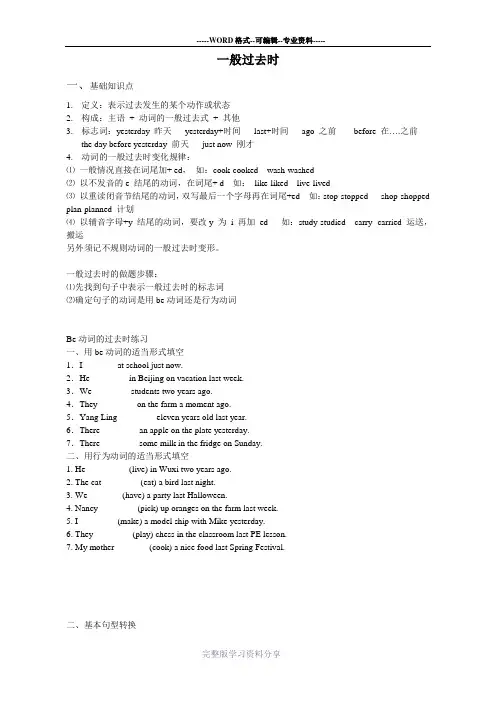
一般过去时一、基础知识点1.定义:表示过去发生的某个动作或状态2.构成:主语+ 动词的一般过去式+ 其他3.标志词:yesterday 昨天yesterday+时间last+时间ago 之前before 在….之前the day before yesterday 前天just now 刚才4.动词的一般过去时变化规律:⑴一般情况直接在词尾加+ ed,如:cook-cooked wash-washed⑵以不发音的e 结尾的动词,在词尾+ d 如:like-liked live-lived⑶以重读闭音节结尾的动词,双写最后一个字母再在词尾+ed 如:stop-stopped shop-shopped plan-planned 计划⑷以辅音字母+y 结尾的动词,要改y 为i 再加ed 如:study-studied carry- carried 运送,搬运另外须记不规则动词的一般过去时变形。
一般过去时的做题步骤:⑴先找到句子中表示一般过去时的标志词⑵确定句子的动词是用be动词还是行为动词Be动词的过去时练习一、用be动词的适当形式填空1.I _______ at school just now.2.He ________ in Beijing on vacation last week.3.We ________ students two years ago.4.They ________ on the farm a moment ago.5.Yang Ling ________ eleven years old last year.6.There ________ an apple on the plate yesterday.7.There ________ some milk in the fridge on Sunday.二、用行为动词的适当形式填空1. He _________ (live) in Wuxi two years ago.2. The cat ________ (eat) a bird last night.3. We _______ (have) a party last Halloween.4. Nancy ________ (pick) up oranges on the farm last week.5. I ________ (make) a model ship with Mike yesterday.6. They ________ (play) chess in the classroom last PE lesson.7. My mother _______ (cook) a nice food last Spring Festival.二、基本句型转换1.一般过去时的否定句构成:有be 动词和没有be 动词两种情况⑴如果有be动词,要先找到be 动词,再在be动词后加not即主语+ be + not + 其他举例:She was very happy.分析:She 为句子主语,was 为be 动词,故She was not very happy. was not= wasn’t⑵如果没有be 动词,我们就要借用助动词didn’t, 并放在动词前面。
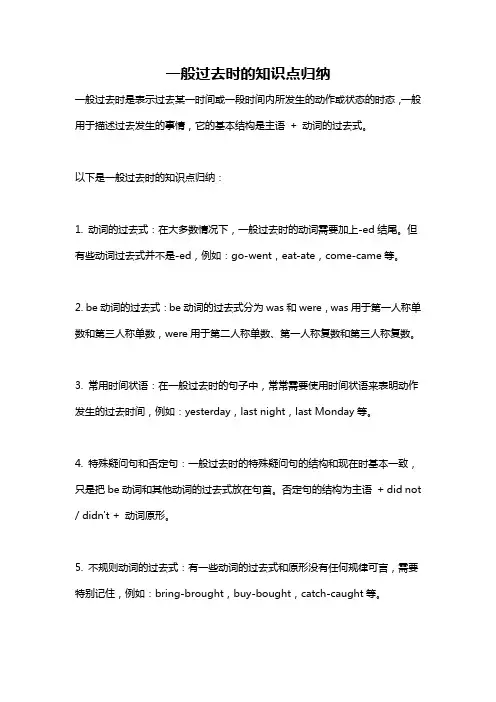
一般过去时的知识点归纳一般过去时是表示过去某一时间或一段时间内所发生的动作或状态的时态,一般用于描述过去发生的事情,它的基本结构是主语+ 动词的过去式。
以下是一般过去时的知识点归纳:1. 动词的过去式:在大多数情况下,一般过去时的动词需要加上-ed结尾。
但有些动词过去式并不是-ed,例如:go-went,eat-ate,come-came等。
2. be动词的过去式:be动词的过去式分为was和were,was用于第一人称单数和第三人称单数,were用于第二人称单数、第一人称复数和第三人称复数。
3. 常用时间状语:在一般过去时的句子中,常常需要使用时间状语来表明动作发生的过去时间,例如:yesterday,last night,last Monday等。
4. 特殊疑问句和否定句:一般过去时的特殊疑问句的结构和现在时基本一致,只是把be动词和其他动词的过去式放在句首。
否定句的结构为主语+ did not / didn't + 动词原形。
5. 不规则动词的过去式:有一些动词的过去式和原形没有任何规律可言,需要特别记住,例如:bring-brought,buy-bought,catch-caught等。
6. 短语动词的过去式:短语动词的过去式一般是由动词原形和前缀或后缀组成,例如:give up-gave up,look for-looked for,break down-broke down等。
7. 时态转换:如果句子中已经使用了过去式的时间状语,那么主语动词不必再使用过去式,而可以使用现在完成式或过去完成式等。
8. 多重动作的描述:当一句话中有多个动作需要被描述时,需要注意动作发生的先后顺序和时态的运用,通常需要使用时间状语、连接词或使用逗号分开多个动作。

英语学习:一般过去时语法解释大全一、基本概念一般过去时是英语中的一种基本时态,表示在过去某个时间发生的动作或状态。
它常用于描述已经发生的事情,特别强调该动作或状态与现在没有直接联系。
二、动词变化1. 规则动词:大多数动词的过去式形式是在动词后面加上-ed。
例如:work-worked, write-wrote。
2. 不规则动词:一些动词的过去式形式与其他动词不同。
例如:be-was/were, have-had, do-did。
3. 特殊情况:有些动词的过去式形式与动词原形相同,如:go-went, see-saw。
三、时间状语一般过去时通常与表示过去的时间状语一起使用,如:yesterday, last night, three days ago等。
四、与其他时态比较1. 现在完成时vs 一般过去时:现在完成时强调动作对现在的影响或结果,而一般过去时只关注过去的动作或状态。
例如:“I have seen the movie”(我已经看过这部电影)应该使用现在完成时,而不是一般过去时。
2. 一般现在时vs 一般过去时:一般现在时描述现在的状态或习惯,而一般过去时描述过去的状态或习惯。
例如:“I usually watch TV at night”(我通常在晚上看电视)应该使用一般现在时,而不是一般过去时。
五、特殊用法1. 表达过去的经验:例如:“I visited Paris last year”(我去年参观了巴黎)。
2. 表达假设条件:例如:“If I were you, I would do it”(如果我是你,我会去做这件事)。
六、与过去进行时的区别1. 时间焦点:过去进行时强调在过去某一段时间正在发生的动作,而一般过去时描述过去的某个时间点发生的动作。
2. 语态选择:过去进行时用于描述过去某个时刻正在进行的动作,通常使用进行体(was/were+动词ing形式),而一般过去时则直接使用动词的过去式形式。
一般过去时的知识点归纳一般过去时知识点归纳一、一般过去时的定义一般过去时(Simple Past Tense)用于描述在过去某个具体时间发生的动作或存在的状态,以及过去经常或反复发生的动作。
二、一般过去时的构成1. 规则动词:一般在动词原形后加-ed。
- 例:worked, played, visited2. 不规则动词:需记忆其过去式形式。
- 例:went, saw, ate三、一般过去时的用法1. 描述过去具体时间发生的动作或状态。
- 例:He walked to school yesterday.2. 表示过去经常或反复发生的动作。
- 例:When I was a child, I often played football after school.3. 用于时间、条件状语从句中,表示过去将来的动作。
- 例:I said I would call her when I got home.四、一般过去时的标志词1. 具体的时间状语:yesterday, last week, in 1990等。
2. 过去的时间状语:a moment ago, just now, the other day等。
3. 频率副词:never, seldom, sometimes, often, usually等。
五、不规则动词的过去式变化1. 改变元音字母:sing-sang, swim-swam2. 改变辅音字母:begin-began, run-ran3. 完全不规则变化:go-went, come-came, eat-ate六、一般过去时与现在完成时的区别1. 一般过去时强调过去某个时间点发生的具体动作,而现在完成时强调过去发生的动作对现在的影响或结果。
- 例:I visited the museum last week. (强调上周的动作)- 例:I have visited the museum before. (强调现在对博物馆的了解)七、一般过去时的否定句和疑问句1. 否定句:在动词前加did not (didn't)。
一般过去时的知识点归纳一般过去时是英语中常见的时态之一,用于描述过去发生的动作、事件或状态。
理解和掌握一般过去时对于我们正确表达过去的经历和故事非常重要。
下面就来详细归纳一下一般过去时的相关知识点。
一、一般过去时的定义和构成一般过去时表示过去某个时间发生的动作或存在的状态。
它通常与表示过去的时间状语连用,如 yesterday(昨天)、last week(上周)、two days ago(两天前)等。
一般过去时的构成分为两种情况:1、对于 be 动词(was / were)第一人称单数(I)和第三人称单数(he、she、it)用 was。
第二人称单数(you)和所有人称的复数(we、you、they)用 were。
例如:I was at home yesterday(我昨天在家。
) They were very happy last night(他们昨晚很开心。
)2、对于实义动词动词的过去式形式。
大多数动词的过去式是在动词原形后加 ed,如 play played,work worked 。
但也有一些不规则动词,它们的过去式需要特殊记忆,比如 go went,have had ,do did 等。
例如:He played football last weekend(他上周末踢足球了。
) She had a big party last month(她上个月举办了一个大型聚会。
)二、一般过去时的用法1、表示过去某个特定时间发生的动作或存在的状态。
例如:I met him in the street yesterday(昨天我在街上遇见了他。
)2、表示过去经常或反复发生的动作。
例如:He often went swimming when he was a child(他小时候经常去游泳。
)3、在时间、条件状语从句中,表示过去将来的动作。
例如:She said she would come if she had time(她说如果有时间她会来。
一般过去时知识点总结1. 什么是一般过去时?一般过去时用于表示在过去某个特定时间发生的动作或存在的状态。
2. 一般过去时的构成一般过去时的肯定句由主语 + 动词的过去式构成,否定句由主语 + 动词的过去式 + "not"构成,疑问句由助动词"did" + 主语 + 动词原形构成。
3. 动词的过去式变化规则- 大多数动词在词尾加上"ed"来构成过去式,如:walked, talked, watched。
- 以"e"结尾的动词只需在词尾加上"d",如:lived, danced。
- 以辅音字母 + "y"结尾的动词,将"y"改为"i"再加上"ed",如:studied, cried。
- 不规则动词的过去式需要单独记忆,如:go-went, have-had。
4. 一般过去时的使用情况- 表示过去的常态或惯性动作,如:She always drank coffee in the morning.- 表示过去发生的事情,如:I saw him at the party yesterday.- 在时间状语从句中,如:I visited my grandparents when I was on vacation.5. 一般过去时的时间状语在一般过去时中,常用的时间状语词包括:yesterday, last week, two days ago, in 1999,等等。
6. 注意事项- 一般过去时只用于过去的时间点或时间段,不能用于现在或将来。
- 一般过去时的动作或状态在过去发生,与现在没有直接的联系。
以上是关于一般过去时的知识点总结,希望对你有所帮助!。
一般过去时知识点
一般过去时
一、基础知识点
1.定义:表示过去发生的某个动作或状态
2.构成:主语 + 动词的一般过去式 + 其他
3.标志词:yesterday 昨天 yesterday+时间 last+时间 ago 之前 before 在….
之前 the day before yesterday 前天 just now 刚才
4.动词的一般过去时变化规律:
⑴一般情况直接在词尾加+ ed,如:cook-cooked wash-washed
⑵以不发音的e 结尾的动词,在词尾+ d 如: like-liked live-lived
⑶以重读闭音节结尾的动词,双写最后一个字母再在词尾+ed 如:stop-stopped shop-shopped plan-planned 计划
⑷以辅音字母+y 结尾的动词,要改y 为 i 再加 ed 如:study-studied carry- carried 运送,搬运
另外须记不规则动词的一般过去时变形。
一般过去时的做题步骤:
⑴先找到句子中表示一般过去时的标志词
⑵确定句子的动词是用be动词还是行为动词
Be动词的过去时练习
一、用be动词的适当形式填空
1.I _______ at school just now.
2.He ________ in Beijing on vacation last week.
3.We ________ students two years ago.
4.They ________ on the farm a moment ago.
5.Yang Ling ________ eleven years old last year.
6.There ________ an apple on the plate yesterday.
7.There ________ some milk in the fridge on Sunday.
二、用行为动词的适当形式填空
1. He _________ (live) in Wuxi two years ago.
2. The cat ________ (eat) a bird last night.
3. We _______ (have) a party last Halloween.
4. Nancy ________ (pick) up oranges on the farm last week.
5. I ________ (make) a model ship with Mike yesterday.
6. They ________ (play) chess in the classroom last PE lesson.
7. My mother _______ (cook) a nice food last Spring Festival.
二、基本句型转换
1.一般过去时的否定句构成:有be 动词和没有 be 动词两种情况
⑴如果有be动词,要先找到be 动词,再在be动词后加not
即主语+ be + not + 其他
举例: She was very happy.
分析:She 为句子主语, was 为 be 动词,
故 She was not very happy. was not= wasn’t
⑵如果没有be 动词,我们就要借用助动词didn’t, 并放在动词前面。
举例: The teacher lived in Guangzhou.
分析:the teacher 为句子主语,lived 为动词,
故 The teacher didn’t live in Guangzhou.
2.一般过去时的一般疑问句构成:有be 动词和没有 be 动词两种情况
⑴对于有be动词的情况:
先找到be动词,再把be 动词提前到句子开头,首字母大写。
即 be + 主语 + 其他
肯定回答: Yes, 主语+ be
否定回答: No, 主语+ be+ not (缩写形式)
⑵对于没有be动词的情况:
①我们就要借用助动词did,并把did 放到句子开头,首字母大写。
②找到句子主语放到did 的后面。
③找到句子中的动词并还原。
即 Did + 主语 + 动词原形 + 其他
3.一般过去时的特殊疑问句构成:
特殊疑问词+一般疑问句
做题前先确定特殊疑问词,再写出一般疑问句
举例:My mother washed the clothes yesterday. ( 就划线部分提问 )
分析:划线部分表示的是时间-昨天,故用when 提问
即:When did your mother wash the clothes?
句型转换练习:
1. The children had a good time in the park.
否定句:__________________________________________
一般疑问句:________________________________________
肯定回答:否定回答
2. There were about nine hundred people at the concert.
否定句:__________________________________________
一般疑问句:________________________________________
肯定回答:否定回答
3. Ann did her homework yesterday evening.
否定句:__________________________________________
一般疑问句:________________________________________
肯定回答:否定回答
4. Last week I read an English book.
否定句:__________________________________________
一般疑问句:________________________________________
肯定回答:否定回答
5. My brother was in the park just now.
否定句:__________________________________________
一般疑问句:________________________________________
肯定回答:否定回答。